Dissertation: Leadership Impact on Productivity in Developing Nations
VerifiedAdded on 2019/12/04
|61
|22126
|44
Thesis and Dissertation
AI Summary
This dissertation investigates the critical role of leadership in project management and its impact on productivity, particularly comparing developing nations like Pakistan to developed countries. It explores the correlation between leadership and productivity, identifying differences in leadership styles and their effects on organizational success. The study employs qualitative methods, including primary and secondary data collection, to analyze why businesses in developing nations often experience lower success rates. The research examines leadership factors, employee satisfaction, productivity impacts, and ineffective leadership in developing nations. The dissertation also delves into the specific leadership approaches used by Pakistani leaders, analyzes leadership theories, and offers recommendations for improving productivity through leadership adjustments. The work highlights the importance of effective project management, the influence of human resource management, and the significance of communication and organizational behavior within the context of leadership.

Dissertation - Modification
1
1
Paraphrase This Document
Need a fresh take? Get an instant paraphrase of this document with our AI Paraphraser
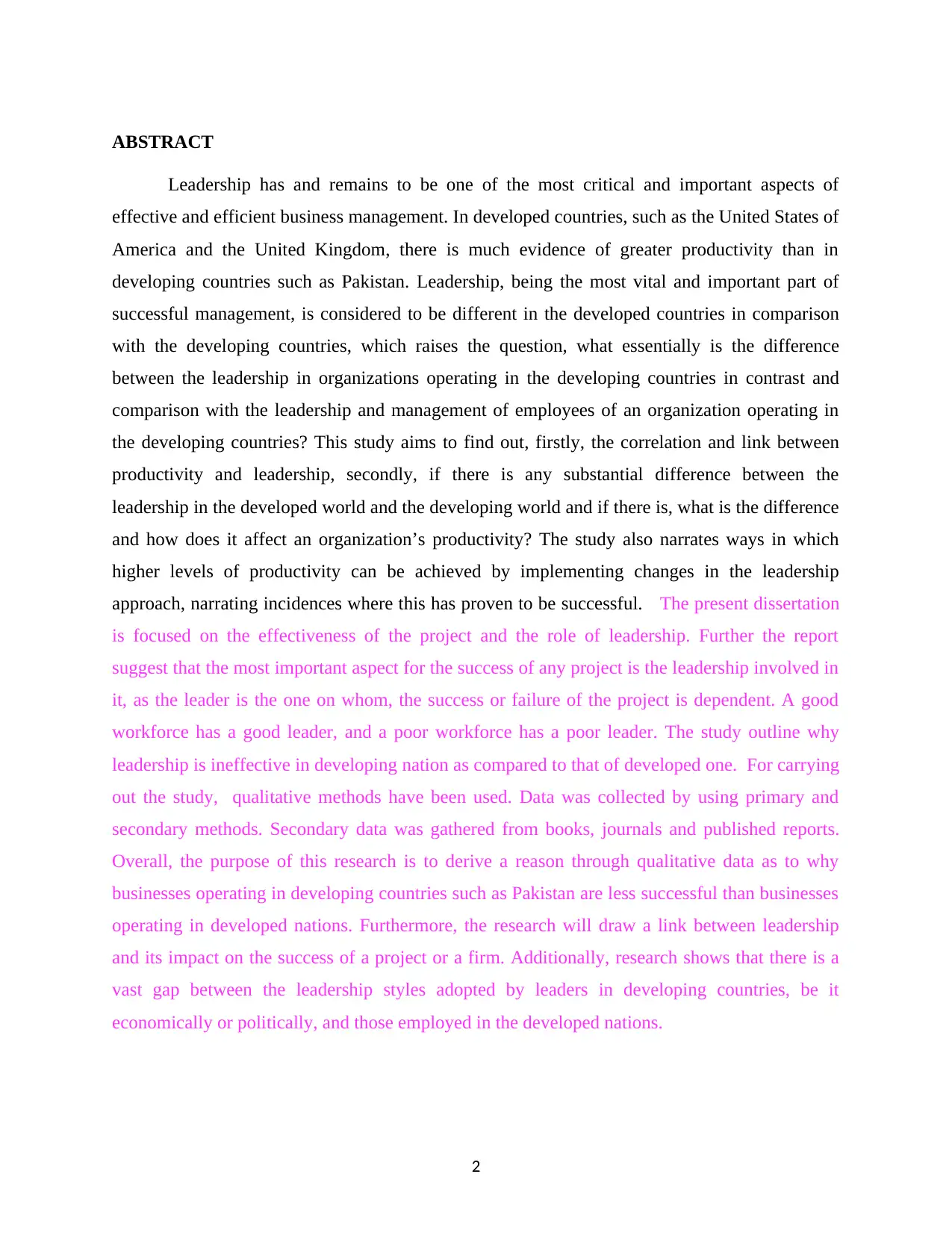
ABSTRACT
Leadership has and remains to be one of the most critical and important aspects of
effective and efficient business management. In developed countries, such as the United States of
America and the United Kingdom, there is much evidence of greater productivity than in
developing countries such as Pakistan. Leadership, being the most vital and important part of
successful management, is considered to be different in the developed countries in comparison
with the developing countries, which raises the question, what essentially is the difference
between the leadership in organizations operating in the developing countries in contrast and
comparison with the leadership and management of employees of an organization operating in
the developing countries? This study aims to find out, firstly, the correlation and link between
productivity and leadership, secondly, if there is any substantial difference between the
leadership in the developed world and the developing world and if there is, what is the difference
and how does it affect an organization’s productivity? The study also narrates ways in which
higher levels of productivity can be achieved by implementing changes in the leadership
approach, narrating incidences where this has proven to be successful. The present dissertation
is focused on the effectiveness of the project and the role of leadership. Further the report
suggest that the most important aspect for the success of any project is the leadership involved in
it, as the leader is the one on whom, the success or failure of the project is dependent. A good
workforce has a good leader, and a poor workforce has a poor leader. The study outline why
leadership is ineffective in developing nation as compared to that of developed one. For carrying
out the study, qualitative methods have been used. Data was collected by using primary and
secondary methods. Secondary data was gathered from books, journals and published reports.
Overall, the purpose of this research is to derive a reason through qualitative data as to why
businesses operating in developing countries such as Pakistan are less successful than businesses
operating in developed nations. Furthermore, the research will draw a link between leadership
and its impact on the success of a project or a firm. Additionally, research shows that there is a
vast gap between the leadership styles adopted by leaders in developing countries, be it
economically or politically, and those employed in the developed nations.
2
Leadership has and remains to be one of the most critical and important aspects of
effective and efficient business management. In developed countries, such as the United States of
America and the United Kingdom, there is much evidence of greater productivity than in
developing countries such as Pakistan. Leadership, being the most vital and important part of
successful management, is considered to be different in the developed countries in comparison
with the developing countries, which raises the question, what essentially is the difference
between the leadership in organizations operating in the developing countries in contrast and
comparison with the leadership and management of employees of an organization operating in
the developing countries? This study aims to find out, firstly, the correlation and link between
productivity and leadership, secondly, if there is any substantial difference between the
leadership in the developed world and the developing world and if there is, what is the difference
and how does it affect an organization’s productivity? The study also narrates ways in which
higher levels of productivity can be achieved by implementing changes in the leadership
approach, narrating incidences where this has proven to be successful. The present dissertation
is focused on the effectiveness of the project and the role of leadership. Further the report
suggest that the most important aspect for the success of any project is the leadership involved in
it, as the leader is the one on whom, the success or failure of the project is dependent. A good
workforce has a good leader, and a poor workforce has a poor leader. The study outline why
leadership is ineffective in developing nation as compared to that of developed one. For carrying
out the study, qualitative methods have been used. Data was collected by using primary and
secondary methods. Secondary data was gathered from books, journals and published reports.
Overall, the purpose of this research is to derive a reason through qualitative data as to why
businesses operating in developing countries such as Pakistan are less successful than businesses
operating in developed nations. Furthermore, the research will draw a link between leadership
and its impact on the success of a project or a firm. Additionally, research shows that there is a
vast gap between the leadership styles adopted by leaders in developing countries, be it
economically or politically, and those employed in the developed nations.
2
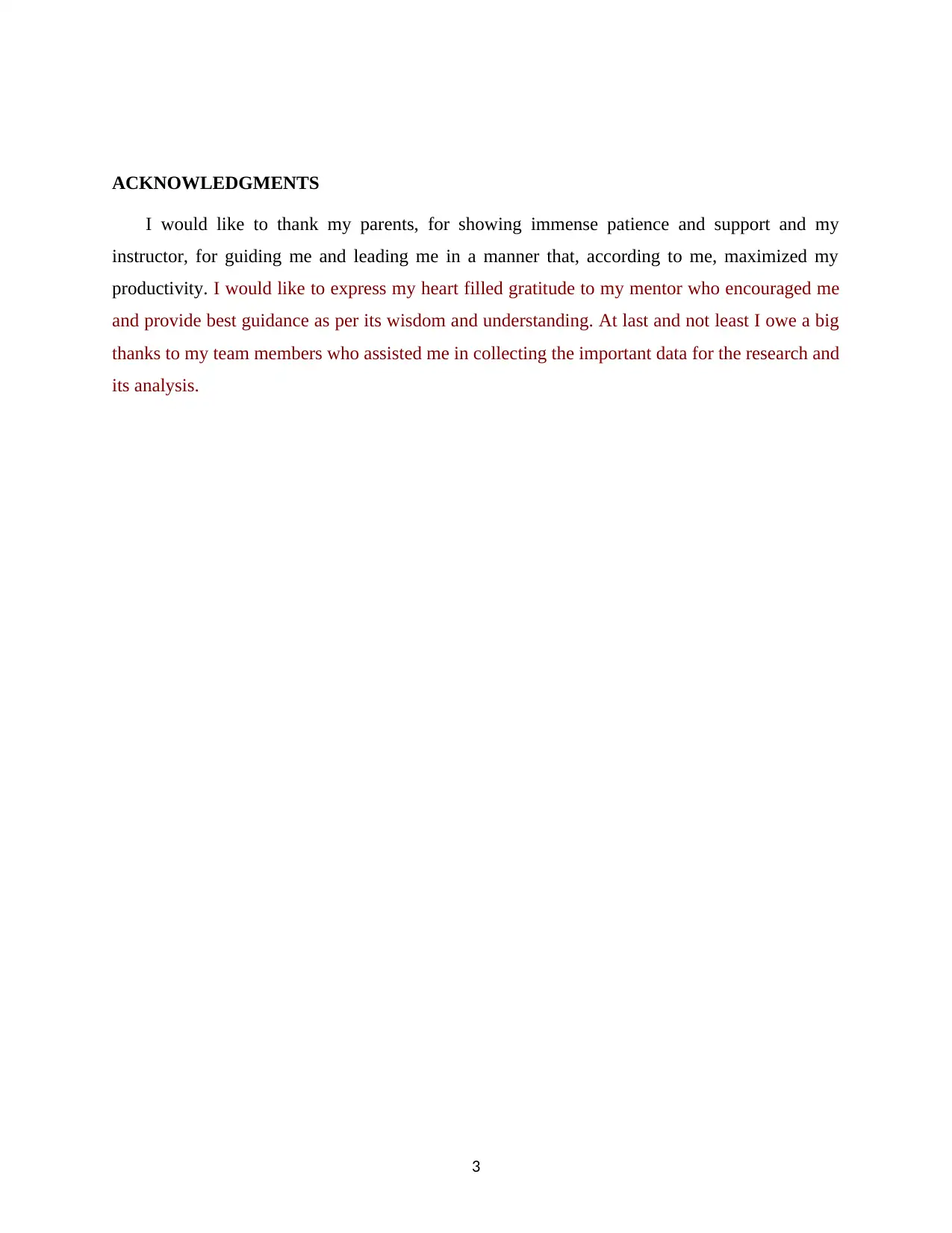
ACKNOWLEDGMENTS
I would like to thank my parents, for showing immense patience and support and my
instructor, for guiding me and leading me in a manner that, according to me, maximized my
productivity. I would like to express my heart filled gratitude to my mentor who encouraged me
and provide best guidance as per its wisdom and understanding. At last and not least I owe a big
thanks to my team members who assisted me in collecting the important data for the research and
its analysis.
3
I would like to thank my parents, for showing immense patience and support and my
instructor, for guiding me and leading me in a manner that, according to me, maximized my
productivity. I would like to express my heart filled gratitude to my mentor who encouraged me
and provide best guidance as per its wisdom and understanding. At last and not least I owe a big
thanks to my team members who assisted me in collecting the important data for the research and
its analysis.
3
⊘ This is a preview!⊘
Do you want full access?
Subscribe today to unlock all pages.

Trusted by 1+ million students worldwide
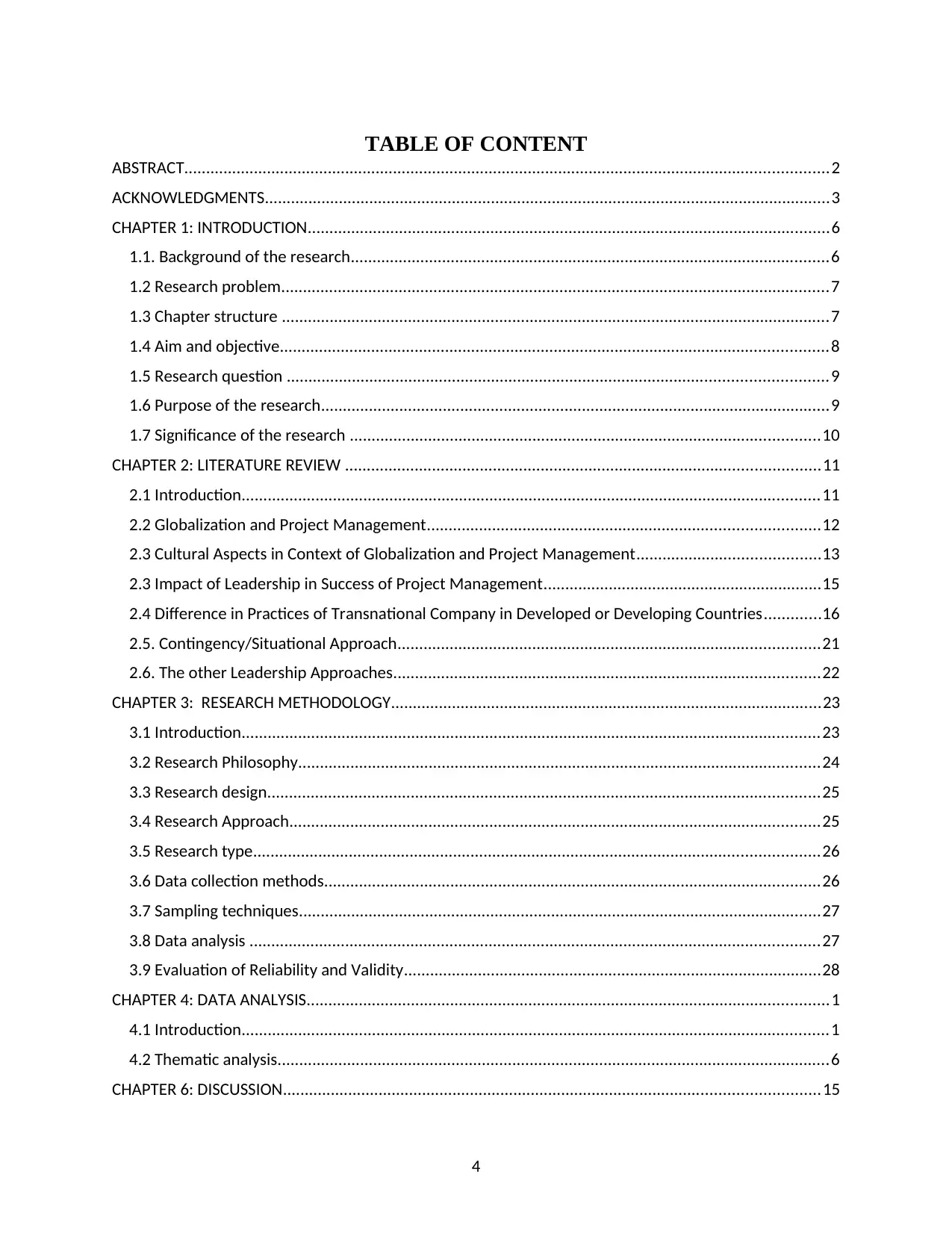
TABLE OF CONTENT
ABSTRACT....................................................................................................................................................2
ACKNOWLEDGMENTS..................................................................................................................................3
CHAPTER 1: INTRODUCTION........................................................................................................................6
1.1. Background of the research..............................................................................................................6
1.2 Research problem..............................................................................................................................7
1.3 Chapter structure ..............................................................................................................................7
1.4 Aim and objective..............................................................................................................................8
1.5 Research question ............................................................................................................................9
1.6 Purpose of the research.....................................................................................................................9
1.7 Significance of the research ............................................................................................................10
CHAPTER 2: LITERATURE REVIEW .............................................................................................................11
2.1 Introduction.....................................................................................................................................11
2.2 Globalization and Project Management..........................................................................................12
2.3 Cultural Aspects in Context of Globalization and Project Management..........................................13
2.3 Impact of Leadership in Success of Project Management................................................................15
2.4 Difference in Practices of Transnational Company in Developed or Developing Countries.............16
2.5. Contingency/Situational Approach.................................................................................................21
2.6. The other Leadership Approaches..................................................................................................22
CHAPTER 3: RESEARCH METHODOLOGY...................................................................................................23
3.1 Introduction.....................................................................................................................................23
3.2 Research Philosophy........................................................................................................................24
3.3 Research design...............................................................................................................................25
3.4 Research Approach..........................................................................................................................25
3.5 Research type..................................................................................................................................26
3.6 Data collection methods..................................................................................................................26
3.7 Sampling techniques........................................................................................................................27
3.8 Data analysis ...................................................................................................................................27
3.9 Evaluation of Reliability and Validity................................................................................................28
CHAPTER 4: DATA ANALYSIS........................................................................................................................1
4.1 Introduction.......................................................................................................................................1
4.2 Thematic analysis...............................................................................................................................6
CHAPTER 6: DISCUSSION...........................................................................................................................15
4
ABSTRACT....................................................................................................................................................2
ACKNOWLEDGMENTS..................................................................................................................................3
CHAPTER 1: INTRODUCTION........................................................................................................................6
1.1. Background of the research..............................................................................................................6
1.2 Research problem..............................................................................................................................7
1.3 Chapter structure ..............................................................................................................................7
1.4 Aim and objective..............................................................................................................................8
1.5 Research question ............................................................................................................................9
1.6 Purpose of the research.....................................................................................................................9
1.7 Significance of the research ............................................................................................................10
CHAPTER 2: LITERATURE REVIEW .............................................................................................................11
2.1 Introduction.....................................................................................................................................11
2.2 Globalization and Project Management..........................................................................................12
2.3 Cultural Aspects in Context of Globalization and Project Management..........................................13
2.3 Impact of Leadership in Success of Project Management................................................................15
2.4 Difference in Practices of Transnational Company in Developed or Developing Countries.............16
2.5. Contingency/Situational Approach.................................................................................................21
2.6. The other Leadership Approaches..................................................................................................22
CHAPTER 3: RESEARCH METHODOLOGY...................................................................................................23
3.1 Introduction.....................................................................................................................................23
3.2 Research Philosophy........................................................................................................................24
3.3 Research design...............................................................................................................................25
3.4 Research Approach..........................................................................................................................25
3.5 Research type..................................................................................................................................26
3.6 Data collection methods..................................................................................................................26
3.7 Sampling techniques........................................................................................................................27
3.8 Data analysis ...................................................................................................................................27
3.9 Evaluation of Reliability and Validity................................................................................................28
CHAPTER 4: DATA ANALYSIS........................................................................................................................1
4.1 Introduction.......................................................................................................................................1
4.2 Thematic analysis...............................................................................................................................6
CHAPTER 6: DISCUSSION...........................................................................................................................15
4
Paraphrase This Document
Need a fresh take? Get an instant paraphrase of this document with our AI Paraphraser
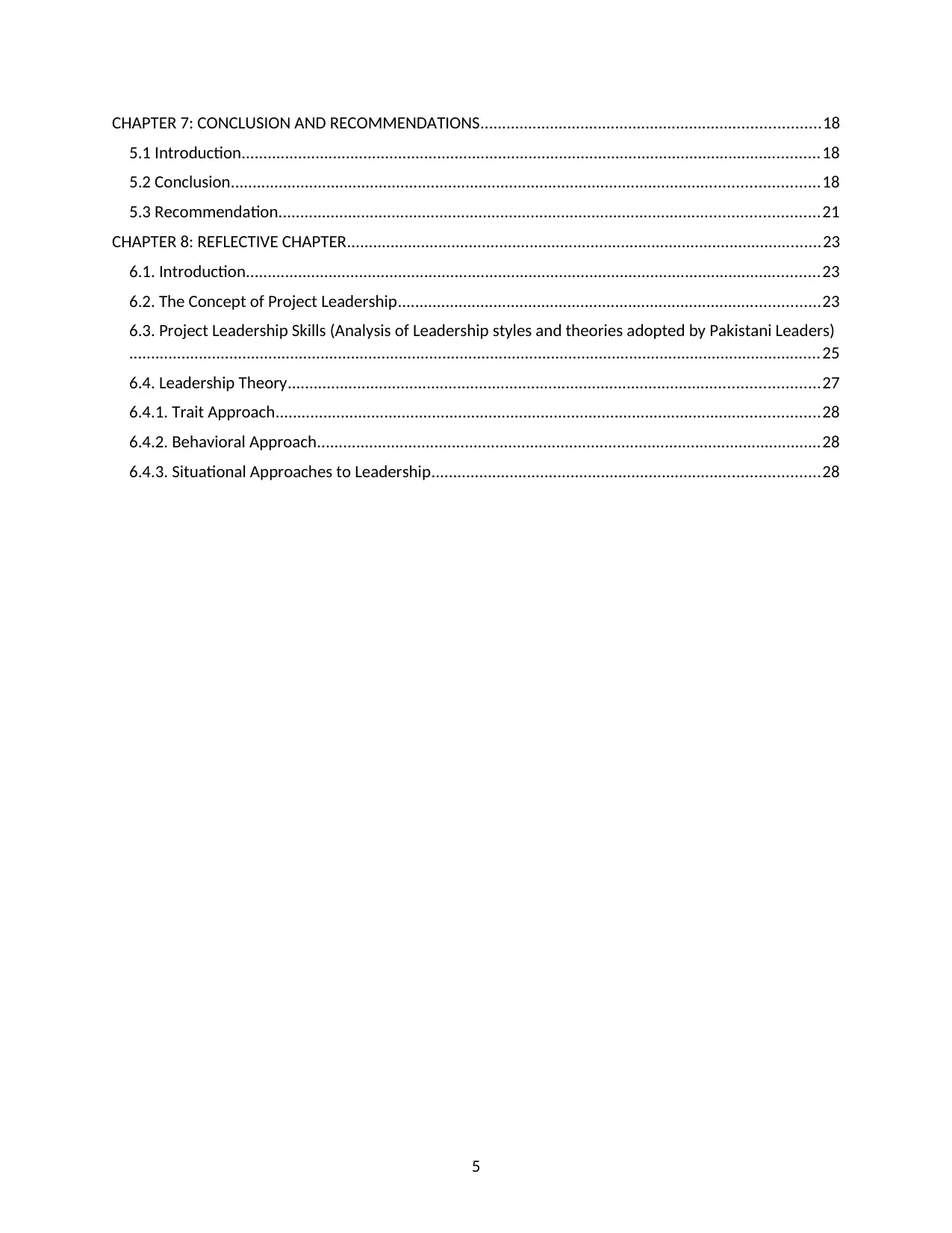
CHAPTER 7: CONCLUSION AND RECOMMENDATIONS..............................................................................18
5.1 Introduction.....................................................................................................................................18
5.2 Conclusion.......................................................................................................................................18
5.3 Recommendation............................................................................................................................21
CHAPTER 8: REFLECTIVE CHAPTER.............................................................................................................23
6.1. Introduction....................................................................................................................................23
6.2. The Concept of Project Leadership.................................................................................................23
6.3. Project Leadership Skills (Analysis of Leadership styles and theories adopted by Pakistani Leaders)
...............................................................................................................................................................25
6.4. Leadership Theory..........................................................................................................................27
6.4.1. Trait Approach.............................................................................................................................28
6.4.2. Behavioral Approach....................................................................................................................28
6.4.3. Situational Approaches to Leadership.........................................................................................28
5
5.1 Introduction.....................................................................................................................................18
5.2 Conclusion.......................................................................................................................................18
5.3 Recommendation............................................................................................................................21
CHAPTER 8: REFLECTIVE CHAPTER.............................................................................................................23
6.1. Introduction....................................................................................................................................23
6.2. The Concept of Project Leadership.................................................................................................23
6.3. Project Leadership Skills (Analysis of Leadership styles and theories adopted by Pakistani Leaders)
...............................................................................................................................................................25
6.4. Leadership Theory..........................................................................................................................27
6.4.1. Trait Approach.............................................................................................................................28
6.4.2. Behavioral Approach....................................................................................................................28
6.4.3. Situational Approaches to Leadership.........................................................................................28
5
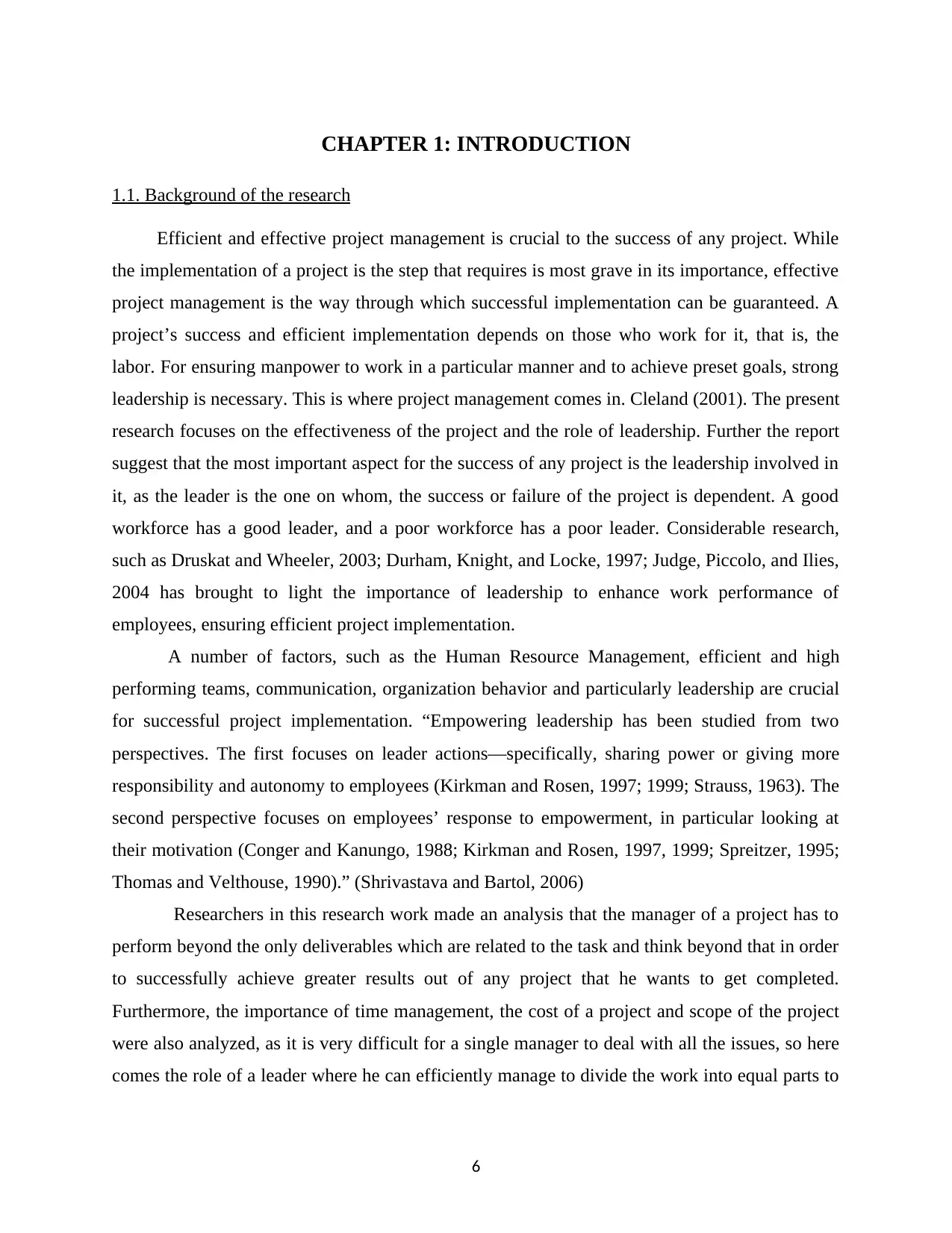
CHAPTER 1: INTRODUCTION
1.1. Background of the research
Efficient and effective project management is crucial to the success of any project. While
the implementation of a project is the step that requires is most grave in its importance, effective
project management is the way through which successful implementation can be guaranteed. A
project’s success and efficient implementation depends on those who work for it, that is, the
labor. For ensuring manpower to work in a particular manner and to achieve preset goals, strong
leadership is necessary. This is where project management comes in. Cleland (2001). The present
research focuses on the effectiveness of the project and the role of leadership. Further the report
suggest that the most important aspect for the success of any project is the leadership involved in
it, as the leader is the one on whom, the success or failure of the project is dependent. A good
workforce has a good leader, and a poor workforce has a poor leader. Considerable research,
such as Druskat and Wheeler, 2003; Durham, Knight, and Locke, 1997; Judge, Piccolo, and Ilies,
2004 has brought to light the importance of leadership to enhance work performance of
employees, ensuring efficient project implementation.
A number of factors, such as the Human Resource Management, efficient and high
performing teams, communication, organization behavior and particularly leadership are crucial
for successful project implementation. “Empowering leadership has been studied from two
perspectives. The first focuses on leader actions—specifically, sharing power or giving more
responsibility and autonomy to employees (Kirkman and Rosen, 1997; 1999; Strauss, 1963). The
second perspective focuses on employees’ response to empowerment, in particular looking at
their motivation (Conger and Kanungo, 1988; Kirkman and Rosen, 1997, 1999; Spreitzer, 1995;
Thomas and Velthouse, 1990).” (Shrivastava and Bartol, 2006)
Researchers in this research work made an analysis that the manager of a project has to
perform beyond the only deliverables which are related to the task and think beyond that in order
to successfully achieve greater results out of any project that he wants to get completed.
Furthermore, the importance of time management, the cost of a project and scope of the project
were also analyzed, as it is very difficult for a single manager to deal with all the issues, so here
comes the role of a leader where he can efficiently manage to divide the work into equal parts to
6
1.1. Background of the research
Efficient and effective project management is crucial to the success of any project. While
the implementation of a project is the step that requires is most grave in its importance, effective
project management is the way through which successful implementation can be guaranteed. A
project’s success and efficient implementation depends on those who work for it, that is, the
labor. For ensuring manpower to work in a particular manner and to achieve preset goals, strong
leadership is necessary. This is where project management comes in. Cleland (2001). The present
research focuses on the effectiveness of the project and the role of leadership. Further the report
suggest that the most important aspect for the success of any project is the leadership involved in
it, as the leader is the one on whom, the success or failure of the project is dependent. A good
workforce has a good leader, and a poor workforce has a poor leader. Considerable research,
such as Druskat and Wheeler, 2003; Durham, Knight, and Locke, 1997; Judge, Piccolo, and Ilies,
2004 has brought to light the importance of leadership to enhance work performance of
employees, ensuring efficient project implementation.
A number of factors, such as the Human Resource Management, efficient and high
performing teams, communication, organization behavior and particularly leadership are crucial
for successful project implementation. “Empowering leadership has been studied from two
perspectives. The first focuses on leader actions—specifically, sharing power or giving more
responsibility and autonomy to employees (Kirkman and Rosen, 1997; 1999; Strauss, 1963). The
second perspective focuses on employees’ response to empowerment, in particular looking at
their motivation (Conger and Kanungo, 1988; Kirkman and Rosen, 1997, 1999; Spreitzer, 1995;
Thomas and Velthouse, 1990).” (Shrivastava and Bartol, 2006)
Researchers in this research work made an analysis that the manager of a project has to
perform beyond the only deliverables which are related to the task and think beyond that in order
to successfully achieve greater results out of any project that he wants to get completed.
Furthermore, the importance of time management, the cost of a project and scope of the project
were also analyzed, as it is very difficult for a single manager to deal with all the issues, so here
comes the role of a leader where he can efficiently manage to divide the work into equal parts to
6
⊘ This is a preview!⊘
Do you want full access?
Subscribe today to unlock all pages.

Trusted by 1+ million students worldwide
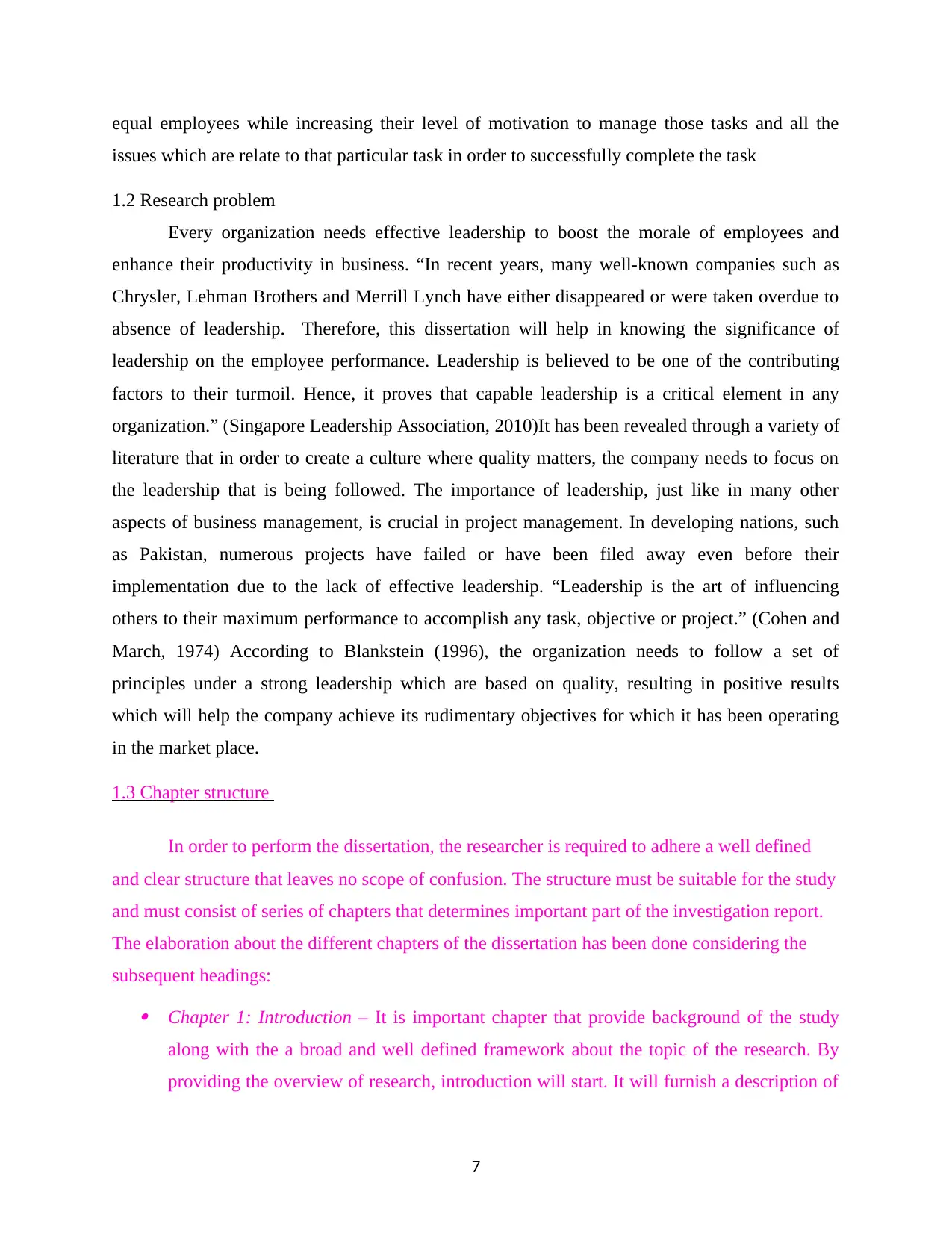
equal employees while increasing their level of motivation to manage those tasks and all the
issues which are relate to that particular task in order to successfully complete the task
1.2 Research problem
Every organization needs effective leadership to boost the morale of employees and
enhance their productivity in business. “In recent years, many well-known companies such as
Chrysler, Lehman Brothers and Merrill Lynch have either disappeared or were taken overdue to
absence of leadership. Therefore, this dissertation will help in knowing the significance of
leadership on the employee performance. Leadership is believed to be one of the contributing
factors to their turmoil. Hence, it proves that capable leadership is a critical element in any
organization.” (Singapore Leadership Association, 2010)It has been revealed through a variety of
literature that in order to create a culture where quality matters, the company needs to focus on
the leadership that is being followed. The importance of leadership, just like in many other
aspects of business management, is crucial in project management. In developing nations, such
as Pakistan, numerous projects have failed or have been filed away even before their
implementation due to the lack of effective leadership. “Leadership is the art of influencing
others to their maximum performance to accomplish any task, objective or project.” (Cohen and
March, 1974) According to Blankstein (1996), the organization needs to follow a set of
principles under a strong leadership which are based on quality, resulting in positive results
which will help the company achieve its rudimentary objectives for which it has been operating
in the market place.
1.3 Chapter structure
In order to perform the dissertation, the researcher is required to adhere a well defined
and clear structure that leaves no scope of confusion. The structure must be suitable for the study
and must consist of series of chapters that determines important part of the investigation report.
The elaboration about the different chapters of the dissertation has been done considering the
subsequent headings: Chapter 1: Introduction – It is important chapter that provide background of the study
along with the a broad and well defined framework about the topic of the research. By
providing the overview of research, introduction will start. It will furnish a description of
7
issues which are relate to that particular task in order to successfully complete the task
1.2 Research problem
Every organization needs effective leadership to boost the morale of employees and
enhance their productivity in business. “In recent years, many well-known companies such as
Chrysler, Lehman Brothers and Merrill Lynch have either disappeared or were taken overdue to
absence of leadership. Therefore, this dissertation will help in knowing the significance of
leadership on the employee performance. Leadership is believed to be one of the contributing
factors to their turmoil. Hence, it proves that capable leadership is a critical element in any
organization.” (Singapore Leadership Association, 2010)It has been revealed through a variety of
literature that in order to create a culture where quality matters, the company needs to focus on
the leadership that is being followed. The importance of leadership, just like in many other
aspects of business management, is crucial in project management. In developing nations, such
as Pakistan, numerous projects have failed or have been filed away even before their
implementation due to the lack of effective leadership. “Leadership is the art of influencing
others to their maximum performance to accomplish any task, objective or project.” (Cohen and
March, 1974) According to Blankstein (1996), the organization needs to follow a set of
principles under a strong leadership which are based on quality, resulting in positive results
which will help the company achieve its rudimentary objectives for which it has been operating
in the market place.
1.3 Chapter structure
In order to perform the dissertation, the researcher is required to adhere a well defined
and clear structure that leaves no scope of confusion. The structure must be suitable for the study
and must consist of series of chapters that determines important part of the investigation report.
The elaboration about the different chapters of the dissertation has been done considering the
subsequent headings: Chapter 1: Introduction – It is important chapter that provide background of the study
along with the a broad and well defined framework about the topic of the research. By
providing the overview of research, introduction will start. It will furnish a description of
7
Paraphrase This Document
Need a fresh take? Get an instant paraphrase of this document with our AI Paraphraser
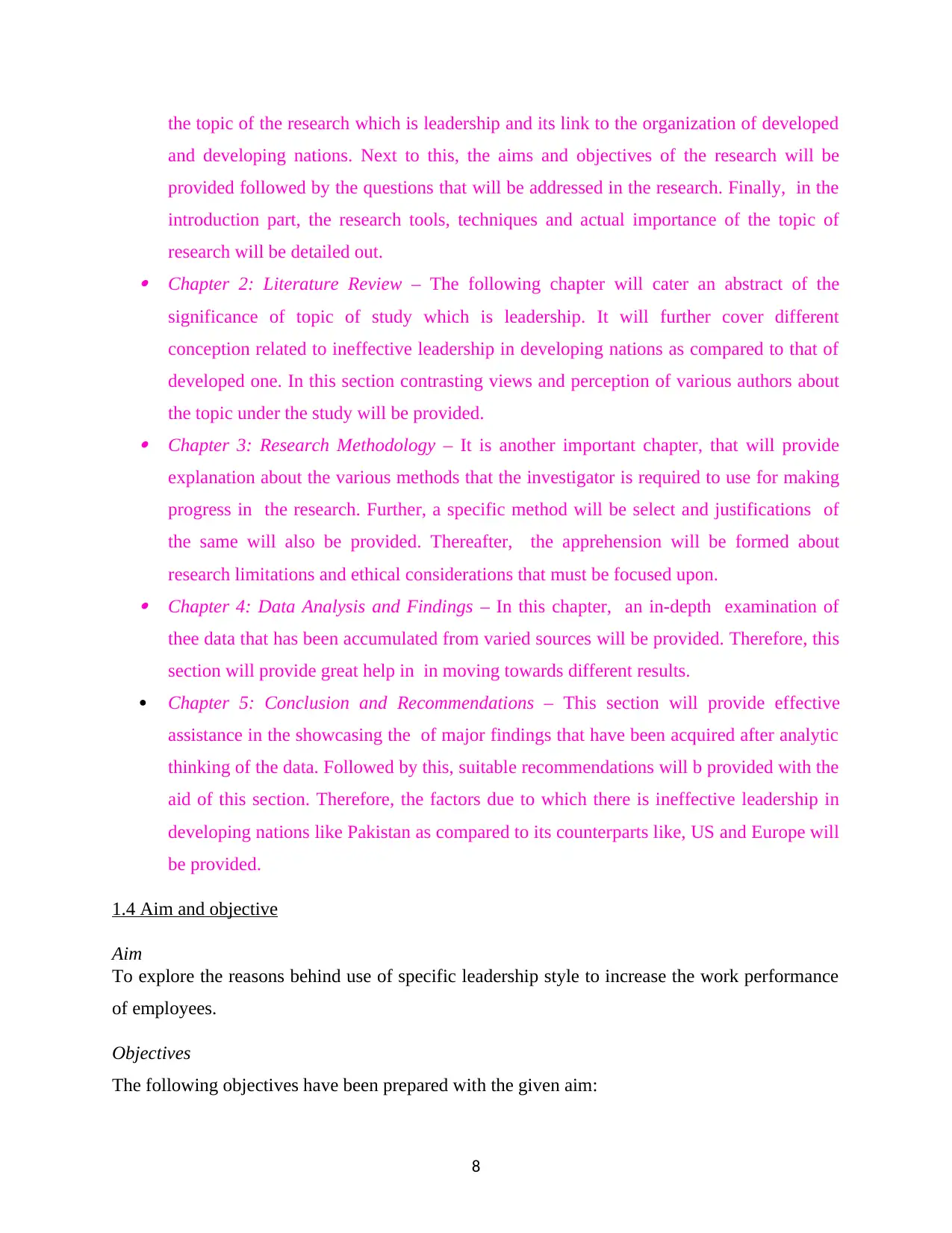
the topic of the research which is leadership and its link to the organization of developed
and developing nations. Next to this, the aims and objectives of the research will be
provided followed by the questions that will be addressed in the research. Finally, in the
introduction part, the research tools, techniques and actual importance of the topic of
research will be detailed out. Chapter 2: Literature Review – The following chapter will cater an abstract of the
significance of topic of study which is leadership. It will further cover different
conception related to ineffective leadership in developing nations as compared to that of
developed one. In this section contrasting views and perception of various authors about
the topic under the study will be provided. Chapter 3: Research Methodology – It is another important chapter, that will provide
explanation about the various methods that the investigator is required to use for making
progress in the research. Further, a specific method will be select and justifications of
the same will also be provided. Thereafter, the apprehension will be formed about
research limitations and ethical considerations that must be focused upon. Chapter 4: Data Analysis and Findings – In this chapter, an in-depth examination of
thee data that has been accumulated from varied sources will be provided. Therefore, this
section will provide great help in in moving towards different results.
Chapter 5: Conclusion and Recommendations – This section will provide effective
assistance in the showcasing the of major findings that have been acquired after analytic
thinking of the data. Followed by this, suitable recommendations will b provided with the
aid of this section. Therefore, the factors due to which there is ineffective leadership in
developing nations like Pakistan as compared to its counterparts like, US and Europe will
be provided.
1.4 Aim and objective
Aim
To explore the reasons behind use of specific leadership style to increase the work performance
of employees.
Objectives
The following objectives have been prepared with the given aim:
8
and developing nations. Next to this, the aims and objectives of the research will be
provided followed by the questions that will be addressed in the research. Finally, in the
introduction part, the research tools, techniques and actual importance of the topic of
research will be detailed out. Chapter 2: Literature Review – The following chapter will cater an abstract of the
significance of topic of study which is leadership. It will further cover different
conception related to ineffective leadership in developing nations as compared to that of
developed one. In this section contrasting views and perception of various authors about
the topic under the study will be provided. Chapter 3: Research Methodology – It is another important chapter, that will provide
explanation about the various methods that the investigator is required to use for making
progress in the research. Further, a specific method will be select and justifications of
the same will also be provided. Thereafter, the apprehension will be formed about
research limitations and ethical considerations that must be focused upon. Chapter 4: Data Analysis and Findings – In this chapter, an in-depth examination of
thee data that has been accumulated from varied sources will be provided. Therefore, this
section will provide great help in in moving towards different results.
Chapter 5: Conclusion and Recommendations – This section will provide effective
assistance in the showcasing the of major findings that have been acquired after analytic
thinking of the data. Followed by this, suitable recommendations will b provided with the
aid of this section. Therefore, the factors due to which there is ineffective leadership in
developing nations like Pakistan as compared to its counterparts like, US and Europe will
be provided.
1.4 Aim and objective
Aim
To explore the reasons behind use of specific leadership style to increase the work performance
of employees.
Objectives
The following objectives have been prepared with the given aim:
8
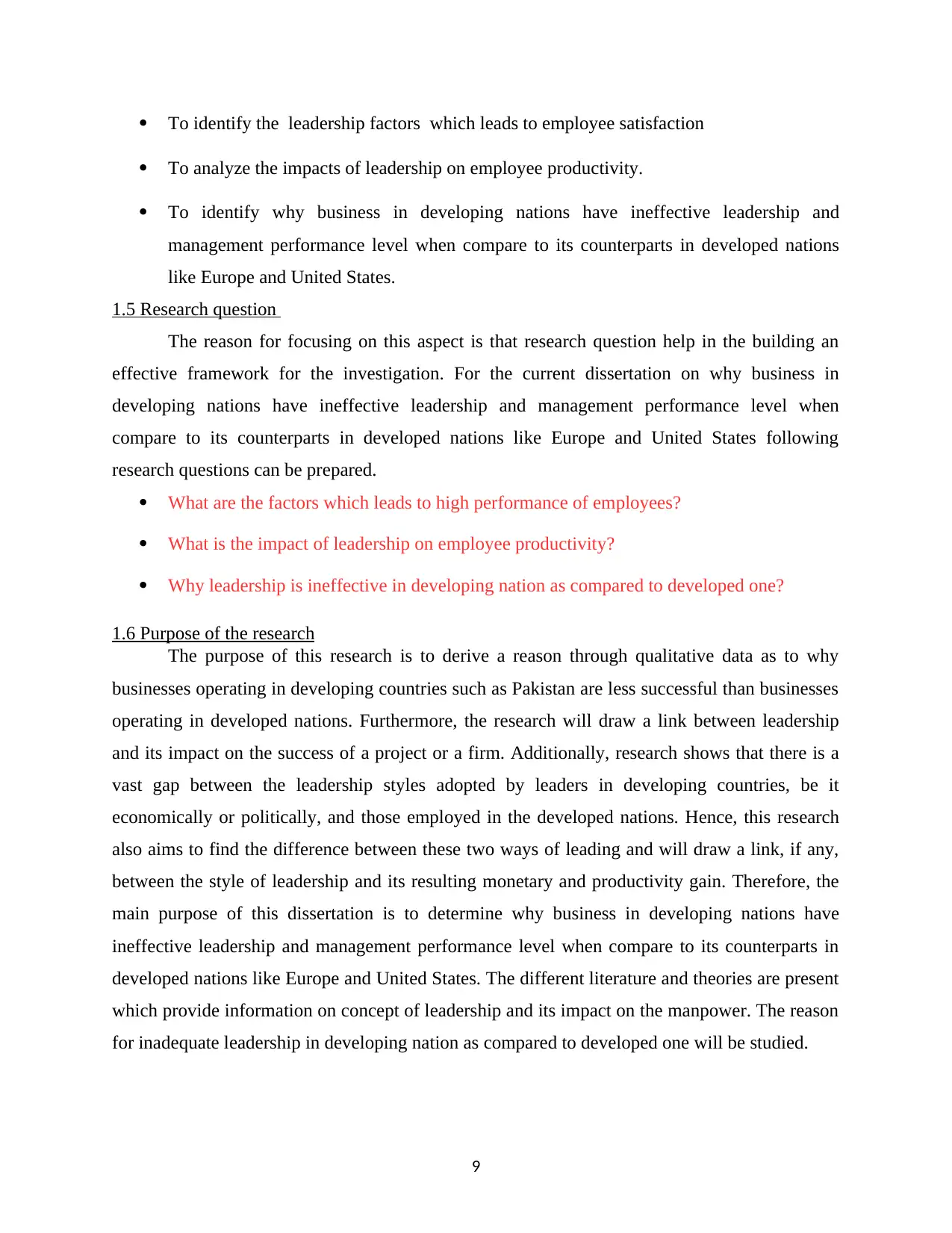
To identify the leadership factors which leads to employee satisfaction
To analyze the impacts of leadership on employee productivity.
To identify why business in developing nations have ineffective leadership and
management performance level when compare to its counterparts in developed nations
like Europe and United States.
1.5 Research question
The reason for focusing on this aspect is that research question help in the building an
effective framework for the investigation. For the current dissertation on why business in
developing nations have ineffective leadership and management performance level when
compare to its counterparts in developed nations like Europe and United States following
research questions can be prepared.
What are the factors which leads to high performance of employees?
What is the impact of leadership on employee productivity?
Why leadership is ineffective in developing nation as compared to developed one?
1.6 Purpose of the research
The purpose of this research is to derive a reason through qualitative data as to why
businesses operating in developing countries such as Pakistan are less successful than businesses
operating in developed nations. Furthermore, the research will draw a link between leadership
and its impact on the success of a project or a firm. Additionally, research shows that there is a
vast gap between the leadership styles adopted by leaders in developing countries, be it
economically or politically, and those employed in the developed nations. Hence, this research
also aims to find the difference between these two ways of leading and will draw a link, if any,
between the style of leadership and its resulting monetary and productivity gain. Therefore, the
main purpose of this dissertation is to determine why business in developing nations have
ineffective leadership and management performance level when compare to its counterparts in
developed nations like Europe and United States. The different literature and theories are present
which provide information on concept of leadership and its impact on the manpower. The reason
for inadequate leadership in developing nation as compared to developed one will be studied.
9
To analyze the impacts of leadership on employee productivity.
To identify why business in developing nations have ineffective leadership and
management performance level when compare to its counterparts in developed nations
like Europe and United States.
1.5 Research question
The reason for focusing on this aspect is that research question help in the building an
effective framework for the investigation. For the current dissertation on why business in
developing nations have ineffective leadership and management performance level when
compare to its counterparts in developed nations like Europe and United States following
research questions can be prepared.
What are the factors which leads to high performance of employees?
What is the impact of leadership on employee productivity?
Why leadership is ineffective in developing nation as compared to developed one?
1.6 Purpose of the research
The purpose of this research is to derive a reason through qualitative data as to why
businesses operating in developing countries such as Pakistan are less successful than businesses
operating in developed nations. Furthermore, the research will draw a link between leadership
and its impact on the success of a project or a firm. Additionally, research shows that there is a
vast gap between the leadership styles adopted by leaders in developing countries, be it
economically or politically, and those employed in the developed nations. Hence, this research
also aims to find the difference between these two ways of leading and will draw a link, if any,
between the style of leadership and its resulting monetary and productivity gain. Therefore, the
main purpose of this dissertation is to determine why business in developing nations have
ineffective leadership and management performance level when compare to its counterparts in
developed nations like Europe and United States. The different literature and theories are present
which provide information on concept of leadership and its impact on the manpower. The reason
for inadequate leadership in developing nation as compared to developed one will be studied.
9
⊘ This is a preview!⊘
Do you want full access?
Subscribe today to unlock all pages.

Trusted by 1+ million students worldwide
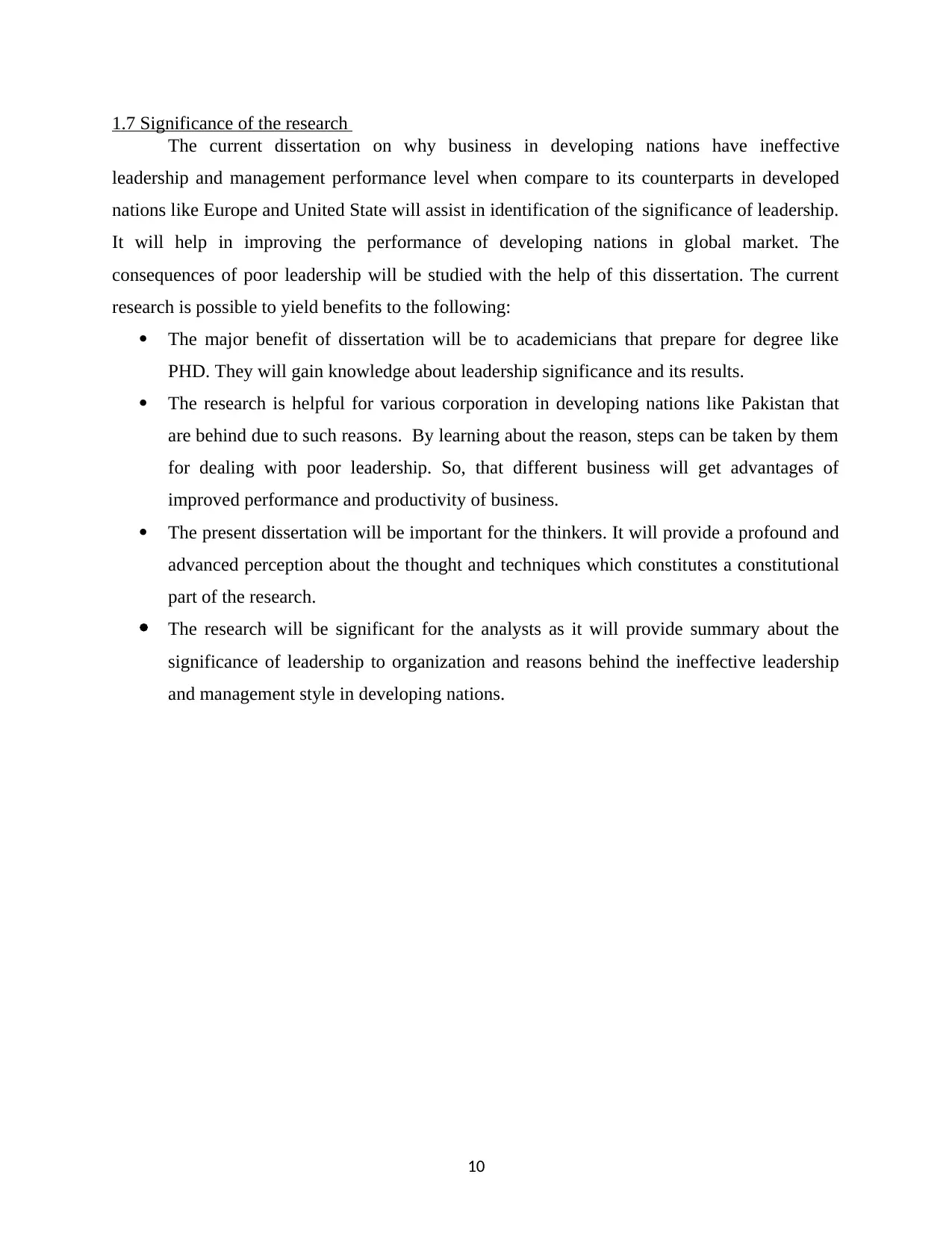
1.7 Significance of the research
The current dissertation on why business in developing nations have ineffective
leadership and management performance level when compare to its counterparts in developed
nations like Europe and United State will assist in identification of the significance of leadership.
It will help in improving the performance of developing nations in global market. The
consequences of poor leadership will be studied with the help of this dissertation. The current
research is possible to yield benefits to the following:
The major benefit of dissertation will be to academicians that prepare for degree like
PHD. They will gain knowledge about leadership significance and its results.
The research is helpful for various corporation in developing nations like Pakistan that
are behind due to such reasons. By learning about the reason, steps can be taken by them
for dealing with poor leadership. So, that different business will get advantages of
improved performance and productivity of business.
The present dissertation will be important for the thinkers. It will provide a profound and
advanced perception about the thought and techniques which constitutes a constitutional
part of the research.
The research will be significant for the analysts as it will provide summary about the
significance of leadership to organization and reasons behind the ineffective leadership
and management style in developing nations.
10
The current dissertation on why business in developing nations have ineffective
leadership and management performance level when compare to its counterparts in developed
nations like Europe and United State will assist in identification of the significance of leadership.
It will help in improving the performance of developing nations in global market. The
consequences of poor leadership will be studied with the help of this dissertation. The current
research is possible to yield benefits to the following:
The major benefit of dissertation will be to academicians that prepare for degree like
PHD. They will gain knowledge about leadership significance and its results.
The research is helpful for various corporation in developing nations like Pakistan that
are behind due to such reasons. By learning about the reason, steps can be taken by them
for dealing with poor leadership. So, that different business will get advantages of
improved performance and productivity of business.
The present dissertation will be important for the thinkers. It will provide a profound and
advanced perception about the thought and techniques which constitutes a constitutional
part of the research.
The research will be significant for the analysts as it will provide summary about the
significance of leadership to organization and reasons behind the ineffective leadership
and management style in developing nations.
10
Paraphrase This Document
Need a fresh take? Get an instant paraphrase of this document with our AI Paraphraser
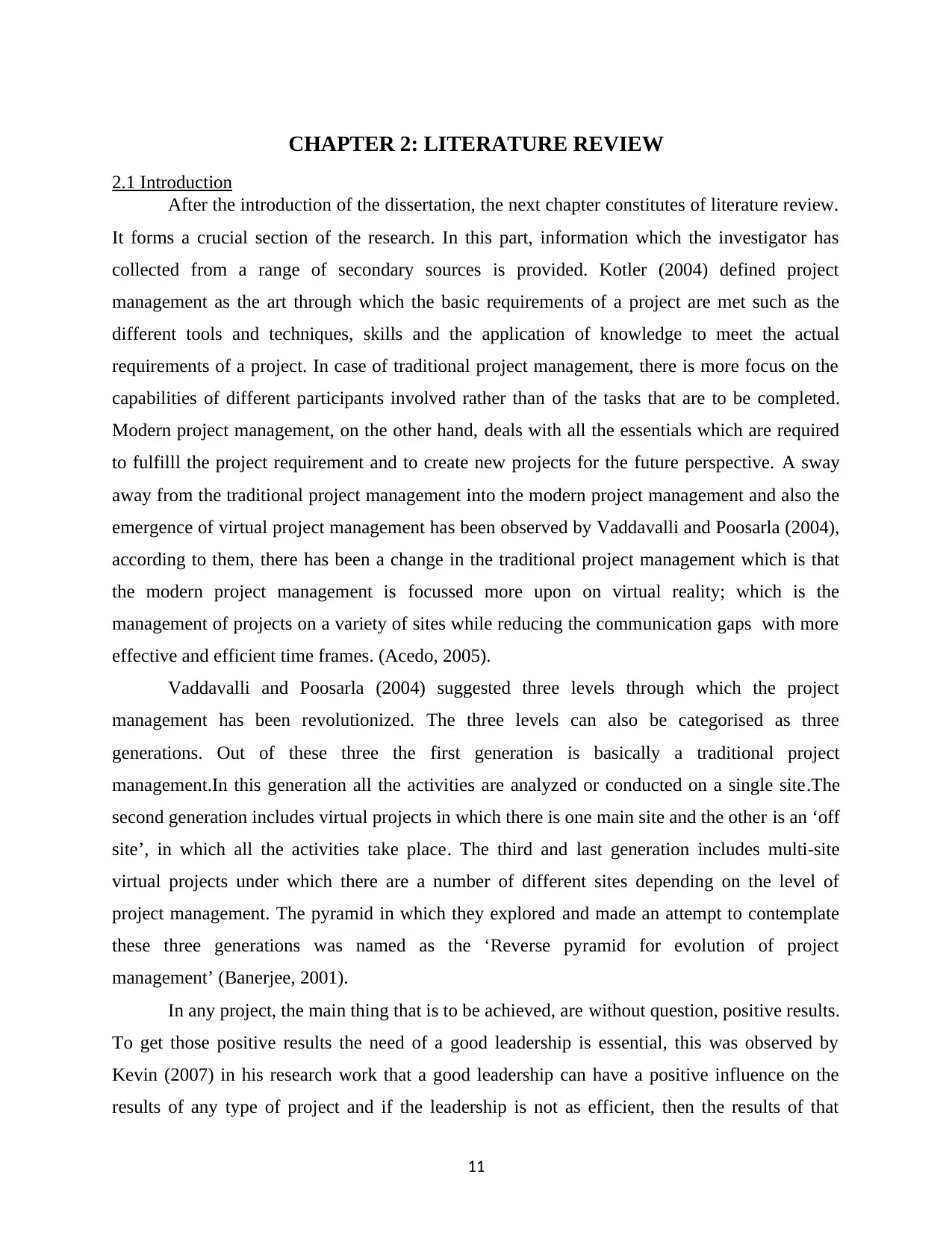
CHAPTER 2: LITERATURE REVIEW
2.1 Introduction
After the introduction of the dissertation, the next chapter constitutes of literature review.
It forms a crucial section of the research. In this part, information which the investigator has
collected from a range of secondary sources is provided. Kotler (2004) defined project
management as the art through which the basic requirements of a project are met such as the
different tools and techniques, skills and the application of knowledge to meet the actual
requirements of a project. In case of traditional project management, there is more focus on the
capabilities of different participants involved rather than of the tasks that are to be completed.
Modern project management, on the other hand, deals with all the essentials which are required
to fulfilll the project requirement and to create new projects for the future perspective. A sway
away from the traditional project management into the modern project management and also the
emergence of virtual project management has been observed by Vaddavalli and Poosarla (2004),
according to them, there has been a change in the traditional project management which is that
the modern project management is focussed more upon on virtual reality; which is the
management of projects on a variety of sites while reducing the communication gaps with more
effective and efficient time frames. (Acedo, 2005).
Vaddavalli and Poosarla (2004) suggested three levels through which the project
management has been revolutionized. The three levels can also be categorised as three
generations. Out of these three the first generation is basically a traditional project
management.In this generation all the activities are analyzed or conducted on a single site.The
second generation includes virtual projects in which there is one main site and the other is an ‘off
site’, in which all the activities take place. The third and last generation includes multi-site
virtual projects under which there are a number of different sites depending on the level of
project management. The pyramid in which they explored and made an attempt to contemplate
these three generations was named as the ‘Reverse pyramid for evolution of project
management’ (Banerjee, 2001).
In any project, the main thing that is to be achieved, are without question, positive results.
To get those positive results the need of a good leadership is essential, this was observed by
Kevin (2007) in his research work that a good leadership can have a positive influence on the
results of any type of project and if the leadership is not as efficient, then the results of that
11
2.1 Introduction
After the introduction of the dissertation, the next chapter constitutes of literature review.
It forms a crucial section of the research. In this part, information which the investigator has
collected from a range of secondary sources is provided. Kotler (2004) defined project
management as the art through which the basic requirements of a project are met such as the
different tools and techniques, skills and the application of knowledge to meet the actual
requirements of a project. In case of traditional project management, there is more focus on the
capabilities of different participants involved rather than of the tasks that are to be completed.
Modern project management, on the other hand, deals with all the essentials which are required
to fulfilll the project requirement and to create new projects for the future perspective. A sway
away from the traditional project management into the modern project management and also the
emergence of virtual project management has been observed by Vaddavalli and Poosarla (2004),
according to them, there has been a change in the traditional project management which is that
the modern project management is focussed more upon on virtual reality; which is the
management of projects on a variety of sites while reducing the communication gaps with more
effective and efficient time frames. (Acedo, 2005).
Vaddavalli and Poosarla (2004) suggested three levels through which the project
management has been revolutionized. The three levels can also be categorised as three
generations. Out of these three the first generation is basically a traditional project
management.In this generation all the activities are analyzed or conducted on a single site.The
second generation includes virtual projects in which there is one main site and the other is an ‘off
site’, in which all the activities take place. The third and last generation includes multi-site
virtual projects under which there are a number of different sites depending on the level of
project management. The pyramid in which they explored and made an attempt to contemplate
these three generations was named as the ‘Reverse pyramid for evolution of project
management’ (Banerjee, 2001).
In any project, the main thing that is to be achieved, are without question, positive results.
To get those positive results the need of a good leadership is essential, this was observed by
Kevin (2007) in his research work that a good leadership can have a positive influence on the
results of any type of project and if the leadership is not as efficient, then the results of that
11
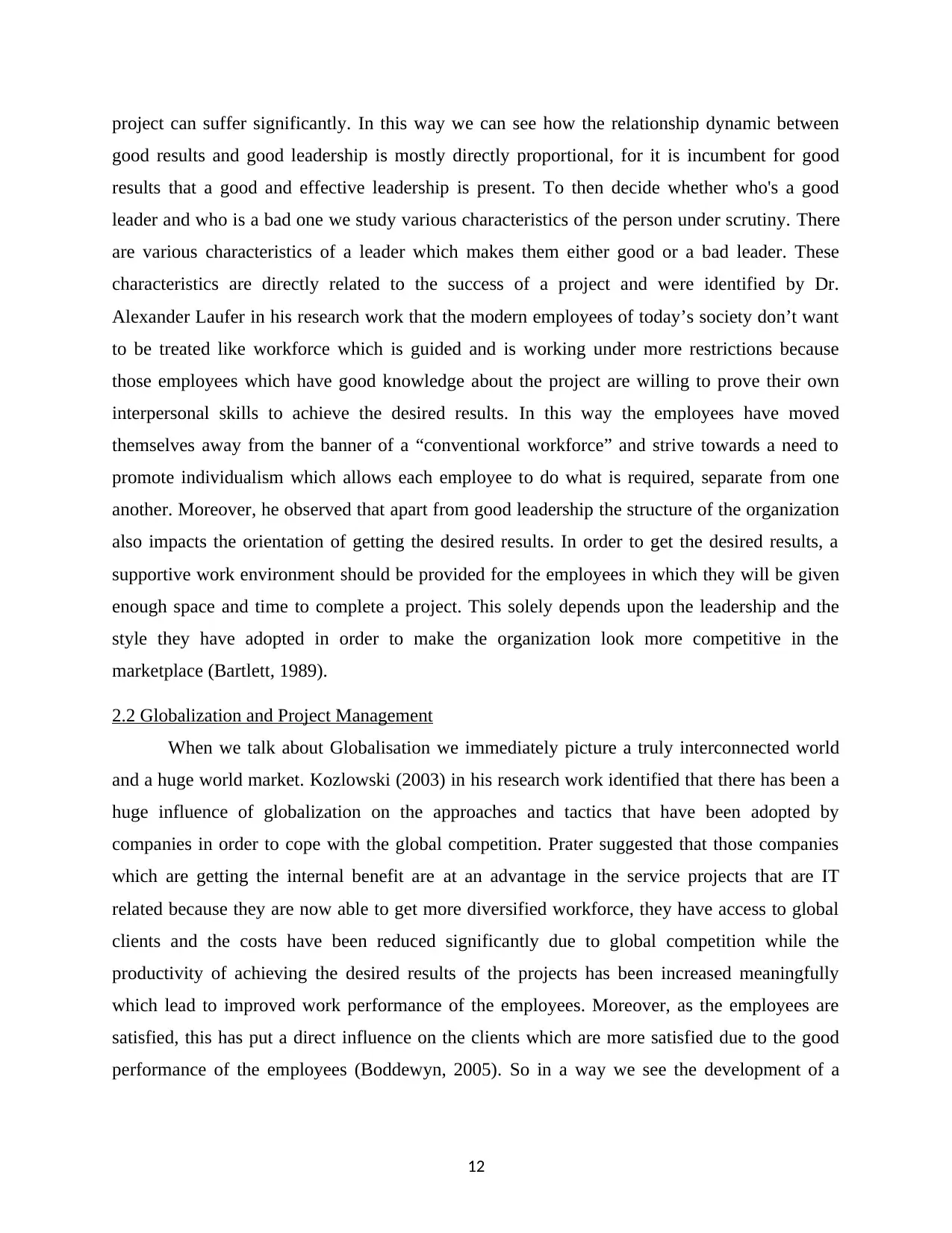
project can suffer significantly. In this way we can see how the relationship dynamic between
good results and good leadership is mostly directly proportional, for it is incumbent for good
results that a good and effective leadership is present. To then decide whether who's a good
leader and who is a bad one we study various characteristics of the person under scrutiny. There
are various characteristics of a leader which makes them either good or a bad leader. These
characteristics are directly related to the success of a project and were identified by Dr.
Alexander Laufer in his research work that the modern employees of today’s society don’t want
to be treated like workforce which is guided and is working under more restrictions because
those employees which have good knowledge about the project are willing to prove their own
interpersonal skills to achieve the desired results. In this way the employees have moved
themselves away from the banner of a “conventional workforce” and strive towards a need to
promote individualism which allows each employee to do what is required, separate from one
another. Moreover, he observed that apart from good leadership the structure of the organization
also impacts the orientation of getting the desired results. In order to get the desired results, a
supportive work environment should be provided for the employees in which they will be given
enough space and time to complete a project. This solely depends upon the leadership and the
style they have adopted in order to make the organization look more competitive in the
marketplace (Bartlett, 1989).
2.2 Globalization and Project Management
When we talk about Globalisation we immediately picture a truly interconnected world
and a huge world market. Kozlowski (2003) in his research work identified that there has been a
huge influence of globalization on the approaches and tactics that have been adopted by
companies in order to cope with the global competition. Prater suggested that those companies
which are getting the internal benefit are at an advantage in the service projects that are IT
related because they are now able to get more diversified workforce, they have access to global
clients and the costs have been reduced significantly due to global competition while the
productivity of achieving the desired results of the projects has been increased meaningfully
which lead to improved work performance of the employees. Moreover, as the employees are
satisfied, this has put a direct influence on the clients which are more satisfied due to the good
performance of the employees (Boddewyn, 2005). So in a way we see the development of a
12
good results and good leadership is mostly directly proportional, for it is incumbent for good
results that a good and effective leadership is present. To then decide whether who's a good
leader and who is a bad one we study various characteristics of the person under scrutiny. There
are various characteristics of a leader which makes them either good or a bad leader. These
characteristics are directly related to the success of a project and were identified by Dr.
Alexander Laufer in his research work that the modern employees of today’s society don’t want
to be treated like workforce which is guided and is working under more restrictions because
those employees which have good knowledge about the project are willing to prove their own
interpersonal skills to achieve the desired results. In this way the employees have moved
themselves away from the banner of a “conventional workforce” and strive towards a need to
promote individualism which allows each employee to do what is required, separate from one
another. Moreover, he observed that apart from good leadership the structure of the organization
also impacts the orientation of getting the desired results. In order to get the desired results, a
supportive work environment should be provided for the employees in which they will be given
enough space and time to complete a project. This solely depends upon the leadership and the
style they have adopted in order to make the organization look more competitive in the
marketplace (Bartlett, 1989).
2.2 Globalization and Project Management
When we talk about Globalisation we immediately picture a truly interconnected world
and a huge world market. Kozlowski (2003) in his research work identified that there has been a
huge influence of globalization on the approaches and tactics that have been adopted by
companies in order to cope with the global competition. Prater suggested that those companies
which are getting the internal benefit are at an advantage in the service projects that are IT
related because they are now able to get more diversified workforce, they have access to global
clients and the costs have been reduced significantly due to global competition while the
productivity of achieving the desired results of the projects has been increased meaningfully
which lead to improved work performance of the employees. Moreover, as the employees are
satisfied, this has put a direct influence on the clients which are more satisfied due to the good
performance of the employees (Boddewyn, 2005). So in a way we see the development of a
12
⊘ This is a preview!⊘
Do you want full access?
Subscribe today to unlock all pages.

Trusted by 1+ million students worldwide
1 out of 61
Related Documents
Your All-in-One AI-Powered Toolkit for Academic Success.
+13062052269
info@desklib.com
Available 24*7 on WhatsApp / Email
![[object Object]](/_next/static/media/star-bottom.7253800d.svg)
Unlock your academic potential
Copyright © 2020–2025 A2Z Services. All Rights Reserved. Developed and managed by ZUCOL.





